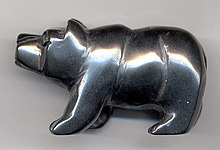Hematite: Difference between revisions
m Do not override user's preferences for thumbnail images without good reasons |
|||
| Line 76: | Line 76: | ||
==References== |
==References== |
||
{{reflist}} |
|||
<references/> |
|||
*[http://www.mindat.org/min-2583.html Martite - Mindat w/ location data] |
*[http://www.mindat.org/min-2583.html Martite - Mindat w/ location data] |
||
Revision as of 13:11, 30 August 2007
| Hematite | |
|---|---|
 | |
| General | |
| Category | Oxide mineral |
| Formula (repeating unit) | iron(III) oxide, Fe2O3, α-Fe2O3 |
| Crystal system | Hexagonal (rhombohedral) |
| Identification | |
| Color | Metallic grey to earthy red |
| Crystal habit | Tabular to thick crystals |
| Cleavage | None |
| Fracture | Uneven to sub-conchoidal |
| Mohs scale hardness | 5.5 - 6.5 |
| Luster | Metallic to splendent |
| Streak | Bright red to dark red |
| Specific gravity | 4.9 - 5.3 |
| Refractive index | Opaque |
| Pleochroism | None |
| References | [1][2] |
Hematite, also spelled haematite, is the mineral form of Iron(III) oxide, (Fe2O3), one of several iron oxides. Hematite crystallizes in the rhombohedral system, and it has the same crystal structure as ilmenite and as corundum. Hematite and ilmenite form a complete solid solution at temperatures above 950°C.

Hematite is a very common mineral, colored black to steel or silver-gray, brown to reddish brown, or red. It is mined as the main ore of iron. Varieties include kidney ore, martite (pseudomorphs after magnetite), iron rose and specularite (specular hematite). While the forms of hematite vary, they all have a rust-red streak. Hematite is harder than pure iron, but much more brittle.
Huge deposits of hematite are found in banded iron formations. Grey hematite is typically found in places where there has been standing water or mineral hot springs, such as those in Yellowstone. The mineral can precipitate out of water and collect in layers at the bottom of a lake, spring, or other standing water. Hematite can also occur without water, however, usually as the result of volcanic activity.
Clay-sized hematite crystals can also occur as a secondary mineral formed by weathering processes in soil, and along with other iron oxides or oxyhydroxides such as goethite, is responsible for the red color of many tropical, ancient, or otherwise highly weathered soils.
The name hematite is derived from the Greek word for blood (haima) because hematite can be red, as in rouge, a powdered form of hematite. The color of hematite lends it well in use as a pigment.

Especially good specimens of hematite come from England, Mexico, Brazil, Australia and the Lake Superior region of the United States and Canada.
Hematite is an antiferromagnetic material below the Morin transition at 260K, and a canted antiferromagnet or weakly ferromagnetic [1] above the Morin transition and below its Néel temperature at 948K, above which it is paramagnetic.

Hematite is part of a complex solid solution oxyhydroxide system having various degrees of water, hydroxyl group, and vacancy substitutions that affect the mineral's magnetic and crystal chemical properties.[3] Two other end-members are referred to as protohematite and hydrohematite.
Hematite on Mars

The spectral signature of hematite was seen on the planet Mars by the infrared spectrometer on the NASA Mars Global Surveyor ("MGS") and 2001 Mars Odyssey spacecraft in orbit around Mars [4]. The mineral was seen in abundance at two sites[5]. on the planet, the Terra Meridiani site, near the Martian equator at 0° longitude, and the second site Aram Chaos near the Valles Marineris [6]. Several other sites also showed hematite, e.g., Aureum Chaos [7]. Because terrestrial hematite is typically a mineral formed in aqueous environments, or by aqueous alteration, this detection was scientifically interesting enough that the second of the two Mars Exploration Rovers was targeted to a site in the Terrra Meridiani region designated Meridiani Planum. In-situ investigations by the Opportunity rover showed a significant amount of hematite, much of it in the form of small spherules that were informally tagged by the science team "blueberries" (a term which is somewhat confusing, since in spectrally-correct color images they are, in fact, silver-grey in color). Analysis indicates that these spherules are apparently concretions formed from a water solution.
Jewelry
Hematite's popularity for in jewelry was at its highest in Europe during the Victorian era. Whilst in the last 50 years it has been popular in North America, especially in the western United States where it is found in jewelry and art created by the Native Americans. Care should be taken in handling hematite items due to the materials susceptibility to damage.
See also

- Iron ore
- Iron oxide
- List of minerals
- Wüstite
- Magnetite
- Mineral redox buffer
- Scientific information from the Mars Exploration Rover mission
References
- ^ http://webmineral.com/data/Hematite.shtml Webmineral data
- ^ http://www.mindat.org/min-1856.html Mindat mineral data
- ^ M.-Z. Dang, D.G. Rancourt, J.E. Dutrizac, G. Lamarche, and R. Provencher. Interplay of Surface Conditions, Particle Size, Stoichiometry, Cell Parameters, and Magnetism in Synthetic Hematite-like Materials. Hyperfine Interactions 117 (1998) 271-319.
- ^ NASA MGS TES Press Release, May 27 1998 "Mars Global Surveyor TES Instrument Identification of Hematite on Mars", available here
- ^ Bandfield, J.L., Global mineral distributions on Mars, J. Geophys Res., 107, 2002. See: Mars Global Data Sets: Hematite Abundance
- ^ Glotch, T. D., and P. R. Christensen (2005), "Geologic and mineralogic mapping of Aram Chaos: Evidence for a water-rich history," J. Geophys. Res., 110, E09006, doi:10.1029/2004JE002389 abstract here
- ^ T. D. Glotch, D. Rogers, and P. R. Christensen, A Newly Discovered Hematite-Rich Unit in Aureum Chaos: Comparison of Hematite and Associated Units With Those in Aram Chaos, Lunar and Planetary Science Conference XXXVI, 2005
External links
- Abandoned Mine Research.
- Mars spheres image.
- Mars trench image showing a shiny texture of half-buried spheres (dark line is equipment shadow)
- Florence Mine, Cumbria, UK.
